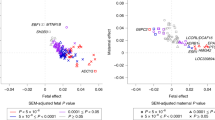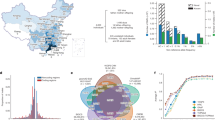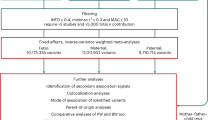Abstract
Birth weight is a common measure of fetal growth that is associated with a range of health outcomes. It is directly affected by the fetal genome and indirectly by the maternal genome. We performed genome-wide association studies on birth weight in the genomes of the child and parents and further analyzed birth length and ponderal index, yielding a total of 243 fetal growth variants. We clustered those variants based on the effects of transmitted and nontransmitted alleles on birth weight. Out of 141 clustered variants, 22 were consistent with parent-of-origin-specific effects. We further used haplotype-specific polygenic risk scores to directly test the relationship between adult traits and birth weight. Our results indicate that the maternal genome contributes to increased birth weight through blood-glucose-raising alleles while blood-pressure-raising alleles reduce birth weight largely through the fetal genome.
This is a preview of subscription content, access via your institution
Access options
Access Nature and 54 other Nature Portfolio journals
Get Nature+, our best-value online-access subscription
$29.99 / 30 days
cancel any time
Subscribe to this journal
Receive 12 print issues and online access
$209.00 per year
only $17.42 per issue
Buy this article
- Purchase on Springer Link
- Instant access to full article PDF
Prices may be subject to local taxes which are calculated during checkout






Similar content being viewed by others
Data availability
The GWAS summary statistics from this study have been deposited at deCODE genetics (https://www.decode.com/summarydata/). Publicly available datasets used in this study were EGG Consortium datasets: http://mccarthy.well.ox.ac.uk/publications/2019/EggBirthWeight_NatureGenetics/Fetal_BW_European_meta.NG2019.txt.gz, http://mccarthy.well.ox.ac.uk/publications/2019/EggBirthWeight_NatureGenetics/Maternal_BW_European_meta.NG2019.txt.gz and https://egg-consortium.org/downloads/EGG-GWAS-BL.txt.gz. Other data generated or analyzed during this study are included in this article and Supplementary Tables 1–12.
Code availability
Custom code has been uploaded to the following GitHub repository: https://github.com/birthw/code.
References
Wilcox, A. J. On the importance—and the unimportance—of birthweight. Int. J. Epidemiol. 30, 1233–1241 (2001).
Roseboom, T. J. et al. Effects of prenatal exposure to the Dutch famine on adult disease in later life: an overview. Mol. Cell. Endocrinol. 185, 93–98 (2001).
D’Urso, S. et al. A cautionary note on using Mendelian randomization to examine the Barker hypothesis and Developmental Origins of Health and Disease (DOHaD). J. Dev. Orig. Health Dis. 1–6 (2020).
Knight, B. et al. Evidence of genetic regulation of fetal longitudinal growth. Early Hum. Dev. 81, 823–831 (2005).
Sørensen, H. T. et al. Birth weight and length as predictors for adult height. Am. J. Epidemiol. 149, 726–729 (1999).
Tyrrell, J. et al. Genetic evidence for causal relationships between maternal obesity-related traits and birth weight. JAMA 315, 1129–1140 (2016).
Horikoshi, M. et al. Genome-wide associations for birth weight and correlations with adult disease. Nature 538, 248–252 (2016).
Knop, M. R. et al. Birth weight and risk of type 2 diabetes mellitus, cardiovascular disease, and hypertension in adults: a meta-analysis of 7 646 267 participants from 135 studies. J. Am. Heart Assoc. 7, e008870 (2018).
Barker, D. J. Intrauterine programming of adult disease. Mol. Med. Today 1, 418–423 (1995).
Hattersley, A. T. & Tooke, J. E. The fetal insulin hypothesis: an alternative explanation of the association of low birthweight with diabetes and vascular disease. Lancet 353, 1789–1792 (1999).
Warrington, N. M. et al. Maternal and fetal genetic effects on birth weight and their relevance to cardio-metabolic risk factors. Nat. Genet. 51, 804–814 (2019).
Warrington, N. M., Freathy, R. M., Neale, M. C. & Evans, D. M. Using structural equation modelling to jointly estimate maternal and fetal effects on birthweight in the UK Biobank. Int. J. Epidemiol. 47, 1229–1241 (2018).
van der Valk, R. J. P. et al. A novel common variant in DCST2 is associated with length in early life and height in adulthood. Hum. Mol. Genet. 24, 1155–1168 (2015).
Kong, A. et al. Detection of sharing by descent, long-range phasing and haplotype imputation. Nat. Genet. 40, 1068–1075 (2008).
Kong, A. et al. Parental origin of sequence variants associated with complex diseases. Nature 462, 868–874 (2009).
Sveinbjornsson, G. et al. Weighting sequence variants based on their annotation increases power of whole-genome association studies. Nat. Genet. 48, 314–317 (2016).
Yang, J. et al. Conditional and joint multiple-SNP analysis of GWAS summary statistics identifies additional variants influencing complex traits. Nat. Genet. 44, 369–375 (2012).
Morison, I. M. & Reeve, A. E. A catalogue of imprinted genes and parent-of-origin effects in humans and animals. Hum. Mol. Genet. 7, 1599–1609 (1998).
Monk, D. Genomic imprinting in the human placenta. Am. J. Obstet. Gynecol. 213, S152–S162 (2015).
Noguer-Dance, M. et al. The primate-specific microRNA gene cluster (C19MC) is imprinted in the placenta. Hum. Mol. Genet. 19, 3566–3582 (2010).
Zink, F. et al. Insights into imprinting from parent-of-origin phased methylomes and transcriptomes. Nat. Genet. 50, 1542–1552 (2018).
Steinthorsdottir, V. et al. Identification of low-frequency and rare sequence variants associated with elevated or reduced risk of type 2 diabetes. Nat. Genet. 46, 294–298 (2014).
Gao, N. et al. Dynamic regulation of Pdx1 enhancers by Foxa1 and Foxa2 is essential for pancreas development. Genes Dev. 22, 3435–3448 (2008).
Barbaux, S. et al. A genome-wide approach reveals novel imprinted genes expressed in the human placenta. Epigenetics 7, 1079–1090 (2012).
Dougherty, C. R. & Jones, A. D. The determinants of birth weight. Am. J. Obstet. Gynecol. 144, 190–200 (1982).
Steer, P. J., Little, M. P., Kold-Jensen, T., Chapple, J. & Elliott, P. Maternal blood pressure in pregnancy, birth weight, and perinatal mortality in first births: prospective study. BMJ 329, 1312 (2004).
Whincup, P. H. et al. Birth weight and risk of type 2 diabetes: a systematic review. JAMA 300, 2886–2897 (2008).
Huxley, R. et al. Is birth weight a risk factor for ischemic heart disease in later life? Am. J. Clin. Nutr. 85, 1244–1250 (2007).
Strawbridge, R. J. et al. Genome-wide association identifies nine common variants associated with fasting proinsulin levels and provides new insights into the pathophysiology of type 2 diabetes. Diabetes 60, 2624–2634 (2011).
Vilhjálmsson, B. J. et al. Modeling linkage disequilibrium increases accuracy of polygenic risk scores. Am. J. Hum. Genet. 97, 576–592 (2015).
Steinthorsdottir, V. et al. Genetic predisposition to hypertension is associated with preeclampsia in European and Central Asian women. Nat. Commun. 11, 5976 (2020).
Cassidy, F. C. & Charalambous, M. Genomic imprinting, growth and maternal–fetal interactions. J. Exp. Biol. 221, jeb164517 (2018).
Mahajan, A. et al. Refining the accuracy of validated target identification through coding variant fine-mapping in type 2 diabetes. Nat. Genet. 50, 559–571 (2018).
Sosenko, I. R. et al. The infant of the diabetic mother: correlation of increased cord C-peptide levels with macrosomia and hypoglycemia. N. Engl. J. Med. 301, 859–862 (1979).
Macdonald-Wallis, C., Tilling, K., Fraser, A., Nelson, S. M. & Lawlor, D. A. Associations of blood pressure change in pregnancy with fetal growth and gestational age at delivery: findings from a prospective cohort. Hypertension 64, 36–44 (2014).
Chen, J. et al. Dissecting maternal and fetal genetic effects underlying the associations between maternal phenotypes, birth outcomes, and adult phenotypes: a Mendelian-randomization and haplotype-based genetic score analysis in 10,734 mother–infant pairs. PLoS Med. 17, e1003305 (2020).
Gudbjartsson, D. F. et al. Large-scale whole-genome sequencing of the Icelandic population. Nat. Genet. 47, 435–444 (2015).
Jónsson, H. et al. Whole genome characterization of sequence diversity of 15,220 Icelanders. Sci. Data 4, 170115 (2017).
McKenna, A. et al. The Genome Analysis Toolkit: a MapReduce framework for analyzing next-generation DNA sequencing data. Genome Res. 20, 1297–1303 (2010).
Loh, P.-R. et al. Efficient Bayesian mixed-model analysis increases association power in large cohorts. Nat. Genet. 47, 284–290 (2015).
Bulik-Sullivan, B. K. et al. LD Score regression distinguishes confounding from polygenicity in genome-wide association studies. Nat. Genet. 47, 291–295 (2015).
Mantel, N. & Haenszel, W. Statistical aspects of the analysis of data from retrospective studies of disease. J. Natl Cancer Inst. 22, 719–748 (1959).
Yang, J., Lee, S. H., Goddard, M. E. & Visscher, P. M. GCTA: a tool for genome-wide complex trait analysis. Am. J. Hum. Genet. 88, 76–82 (2011).
Welsh, S., Peakman, T., Sheard, S. & Almond, R. Comparison of DNA quantification methodology used in the DNA extraction protocol for the UK Biobank cohort. BMC Genomics 18, 26 (2017).
Acknowledgements
We thank the participants of this study and the investigators of the FinnGen study. Part of this work was conducted using the UKBB resource (application no. 56270).
Author information
Authors and Affiliations
Contributions
T.J., V.S., H.H., D.F.G., G. Thorleifsson, U.T. and K.S. designed the study and interpreted the results. V.S., A.H., G. Thorgeirsson, R.B., E.L.S., D.O.A., T.S. and I.J. carried out participant ascertainment and recruitment. T.J., V.S., L.S., G.S., E.V.I., R.B.T., J.K.S., V.T., K.E.H., M.L.F., D.F.G. and G. Thorleifsson performed the statistical and bioinformatics analyses. T.J., V.S., U.T. and K.S. drafted the manuscript. All authors contributed to the final version of the manuscript.
Corresponding authors
Ethics declarations
Competing interests
T.J., V.S., L.S., G.S., E.V.I., R.B.T., J.K.S., V.T., K.E.H., A.H., M.L.F., G. Thorgeirsson, D.O.A., I.J., H.H., D.F.G., G. Thorleifsson, U.T. and K.S. are affiliated with deCODE Genetics/Amgen and declare competing interests as employees. The other authors declare no competing interests.
Additional information
Peer review information Nature Genetics thanks Rachel Freathy and David Evans for their contribution to the peer review of this work.
Publisher’s note Springer Nature remains neutral with regard to jurisdictional claims in published maps and institutional affiliations.
Extended data
Extended Data Fig. 1 Birth weight, offspring birth weight mothers and gestational age.
a,b, Effect estimates for fetal growth variants for gestational age vs. birth weight(adj for gestational age) in the Icelandic fetal (a) and maternal (b) GWAS analysis. Error bars shown for sequence variants with P < 5.1 × 10−4 in the corresponding birth weight analysis represent 95% CI. Effect estimates for gestational age were obtained by linear regression of gestational age against fetal growth variants in the Icelandic data. Effects are shown for the birth weight increasing allele based on the Icelandic fetal and maternal data, respectively. c,d, P-values for the fetal growth variants for the birth weight and birth weight mothers analysis with and without adjusting for gestational age. The log10 P-values of birth weight with and without adjusting for gestational age in the Icelandic fetal GWAS data (n = 125,541) (c). The log10 P-values of birth weight with and without adjusting for gestational age in the Icelandic maternal GWAS data (n = 59,735) (d). The name of the nearest gene is shown in black if P < 5 × 10−8. Note that for the COL27A1 variant the birth weight increasing allele in the Icelandic data differs from the one in the birth weight meta-analysis. The dashed grey line represents results from a simple linear regression using MAF (1 - MAF) as weights and the solid grey line indicates the reference line with slope = 1. GA, gestational age; BW, birth weight; OS, offspring.
Extended Data Fig. 2 Sequence variants associating with birth length and their effects on birth weight and birth length.
The figure shows effect estimates for birth weight and birth length, from linear regression of trait values on genotype counts, for sequence variants associating with birth length. Error bars, shown for sequence variants with P < 5.1 × 10−4, represent 95% confidence intervals for the estimates. Only one of the 10 birth length variants (within MTRMR11) does not also associate with birth weight. Effects are shown for the birth length increasing allele based on the birth length meta-analysis (n = 154,000). Variants are labelled with their nearest gene. The dashed grey line represents results from a simple linear regression using MAF (1 - MAF) as weights and the solid grey line indicates the reference line with slope = 1.
Extended Data Fig. 3 Discovery of 243 fetal growth variants in five fetal growth analyses.
Variants from the five sets of analyses (birth weight, birth length, ponderal index of the child’s genomes and offspring birth weight of the maternal and paternal genomes) were combined into one set of fetal growth variants. Variants were considered to belong to the same locus if they were within 500 kb apart and in linkage disequilibrium (LD) with r2 ≥ 0.1. Only one variant (near EPAS1) was identified in all five analyses, and one variant (near LINC00880) was identified in all sets apart from birth length.
Extended Data Fig. 4 Mode of action of rs10814916 in GLIS3.
The paternal transmitted allele is indicated in blue and non-transmitted paternal allele in cyan, and the maternal transmitted allele in red and maternal non-transmitted allele pink. The data is shown as effect of each allele on birth weight (in SD), with 95% CI, on the y-axes for the transmitted alleles and maternally non-transmitted allele. The effects are estimated jointly using maximum likelihood estimations on 104,920 parent-offspring trios. Effects are shown for rs10814916-A.
Extended Data Fig. 5 Heatmap displaying effects of variants associating with birth weight and cardiovascular traits arranged by mode of transmission clusters.
Variants associating with any of the three cardiovascular traits (SBP, hypertension or CAD) with P < 2.1 × 10−4 (0.05/number of independent variants (n = 243)) and a defined mode of transmission are shown. The effects, log(OR) or beta, were obtained from logistic or linear regression, respectively, of case/control status or trait values on genotype count of the sequence variant. The colors represent the effects of the 26 variants associating with the traits shown on the y-axis, with red indicative of a positive effect and blue of a negative effect. Effects are shown for the SBP increasing allele and variants are ordered first by their mode of transmission cluster classification and then by their effect on SBP. The effect is shown if the associating P-value is below 0.05. A filled circle represents P < 1 × 10−8 and an open circle P < 1 × 10−6. Transmission clusters: M, maternal effect; FM, fetal and maternal effect; FMN, no effect of the maternally transmitted allele; fM, fetal and maternal, with stronger maternal effect; Fm, fetal and maternal, with stronger fetal effect; PatT, paternally transmitted only effect; MatT, maternally transmitted only effect; F, fetal effect, independent of parent-of-origin. Birth weight (BW) phenotypes: BW mother and BW represent the corresponding meta-analyses, BWPT (paternally transmitted), BWMT (maternally transmitted) and BWMNT (maternally non-transmitted) are based on allele specific BW GWAS of Icelandic individuals and BWchild represents the Icelandic BW GWAS data. Abbreviations: SD, same direction; OD, opposite direction.
Extended Data Fig. 6 Heatmap displaying the effects of PRSs for adult cardio-metabolic traits on fetal growth traits by different transmission modes.
Effects are shown if P < 0.05, with positive associations represented in red and negative associations in blue. The P values and effects are from a linear regression of fetal trait values on PRS’s, adjusting for year of birth, gender and principal components. PRS for cardiovascular (CAD, hypertension and SBP), glycemic (T2D, HbA1c and glucose) and anthropometric (height, BMI and WHRadjBMI) traits were generated based on GWAS data from UK Biobank data for genotyped Icelandic individuals, and tested against the Icelandic fetal growth phenotypes. PRS for the transmitted and non-transmitted maternal (MT and MNT) and paternal (PT and PNT) alleles were tested separately using genotyped individuals only while Mother, Child and Father are based on the entire corresponding Icelandic GWAS data. The PRS were tested against birth weight, birth length, ponderal index, gestational age, as well as birth weight not adjusted for gestational age (BWunadjusted) and birth weight adjusted for birth length (BWadjBL).
Extended Data Fig. 7 Heatmap displaying effects of variants associating with birth weight and anthropometric traits arranged by mode of transmission clusters.
Variants associating with any of the three anthropometric traits (height, WHRadjBMI or BMI) with a P < 2.1 × 10−4 (0.05/number of independent variants (n = 243)) and a defined mode of transmission are shown. The effects, log(OR) or beta, were obtained from logistic or linear regression, respectively, of case/control status or trait values on genotype count of the sequence variant. The colors represent the effects of the 83 variants associating with the traits shown on the y-axis, with red indicative of a positive effect and blue of a negative effect. Effects are shown for the height increasing allele and variants are ordered first by their mode of transmission cluster classification and then by their effect on height. The effect is shown if the associating P-value is below 0.05. A filled circle represents P < 1 × 10−8 and an open circle P < 1 × 10−6. Transmission clusters: M, maternal effect; FM, fetal and maternal effect; FMN, no effect of the maternally transmitted allele; fM, fetal and maternal, with stronger maternal effect; Fm, fetal and maternal, with stronger fetal effect; PatT, paternally transmitted only effect; MatT, maternally transmitted only effect; F, fetal effect, independent of parent-of-origin. Birth weight (BW) phenotypes: BW mother and BW represent the corresponding meta-analyses, BWPT (paternally transmitted), BWMT (maternally transmitted) and BWMNT (maternally non-transmitted) are based on allele specific BW GWAS of Icelandic individuals and BWchild represents the Icelandic BW GWAS data. Abbreviations: SD, same direction; OD, opposite direction.
Extended Data Fig. 8 Cluster probability as a function of strength of association.
The figure shows the maximum probability that a sequence variant belongs to a specific cluster compared to the maximum Z-score for the association of the paternally and maternally transmitted and maternally non-transmitted alleles with birth weight.
Supplementary information
Rights and permissions
About this article
Cite this article
Juliusdottir, T., Steinthorsdottir, V., Stefansdottir, L. et al. Distinction between the effects of parental and fetal genomes on fetal growth. Nat Genet 53, 1135–1142 (2021). https://doi.org/10.1038/s41588-021-00896-x
Received:
Accepted:
Published:
Issue Date:
DOI: https://doi.org/10.1038/s41588-021-00896-x
This article is cited by
-
Disentangling the link between maternal influences on birth weight and disease risk in 36,211 genotyped mother–child pairs
Communications Biology (2024)
-
The Born in Guangzhou Cohort Study enables generational genetic discoveries
Nature (2024)
-
Opposite causal effects of birthweight on myocardial infarction and atrial fibrillation and the distinct mediating pathways: a Mendelian randomization study
Cardiovascular Diabetology (2023)
-
Large-scale genome sequencing redefines the genetic footprints of high-altitude adaptation in Tibetans
Genome Biology (2023)
-
The influence of insulin-related genetic variants on fetal growth, fetal blood flow, and placental weight in a prospective pregnancy cohort
Scientific Reports (2023)



